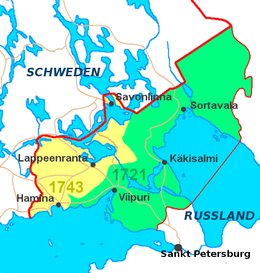Old Finland
This article has multiple issues. Please help improve it or discuss these issues on the talk page. (Learn how and when to remove these template messages)
|


Old Finland (
History
- In the Treaty of Nystad (1721) that concluded the Great Northern War, Sweden was forced to cede Käkisalmi County and Viborg/Viipuri County to Russia. The ceded Finnish-speaking Ingria around Saint Petersburg, however, was not included in Old Finland.
- In the Kymi river and around Savonlinnato Russia.
The Russian ruler guaranteed religion, property rights, old Swedish laws, and some privileges to the inhabitants of these territories. However, a circumvention occurred, as the Russian administrators and Russian military were unfamiliar with the Swedish system. The Russians were used to a different system with its serfs, serfdom. As a result, the economy of the area was markedly different from that on the other side of the border.
The ruler's guarantee froze the situation. Thus legal developments in Sweden were not introduced to these areas: the Viipuri and Käkisalmi territory did not adopt the 1734 General Law of Sweden (though
The territories enjoyed a sort of
Under Russian rule the combined territories formed the Vyborg Governorate, or Government of Vyborg.
Ecclesiastically, the areas were administered as a diocese, but without a
The area was not forced to contribute men to the Russian Army until 1797. However, there were many non-Finnish troops in the area, especially after the 1788–90 war.
Scandinavian-style district courts continued in judicial function, each with a judge and lay members. However, the Russian estate owners and military often ignored these courts' decisions and imposed illegal punishments on the peasants.
Because of the absence of an evenly applied, up-to-date legal system in the area, apathy in some ways dominated among Old Finland's residents; and not many figures from the area have a prominent place in history. Two of these are
These areas, Government of Vyborg, were later referred to as Old Finland; and from the beginning of 1812, they were incorporated in the
See also
Sources
Further reading
- Viipurin läänin liittäminen muun Suomen yhteyteen, A. Danielsson-Kalmari
References
- ^ "Vanha Suomi syntyi ennen Suomen suuriruhtinaskuntaa". Helsingin Sanomat (in Finnish). December 12, 2017. Retrieved October 17, 2021.
